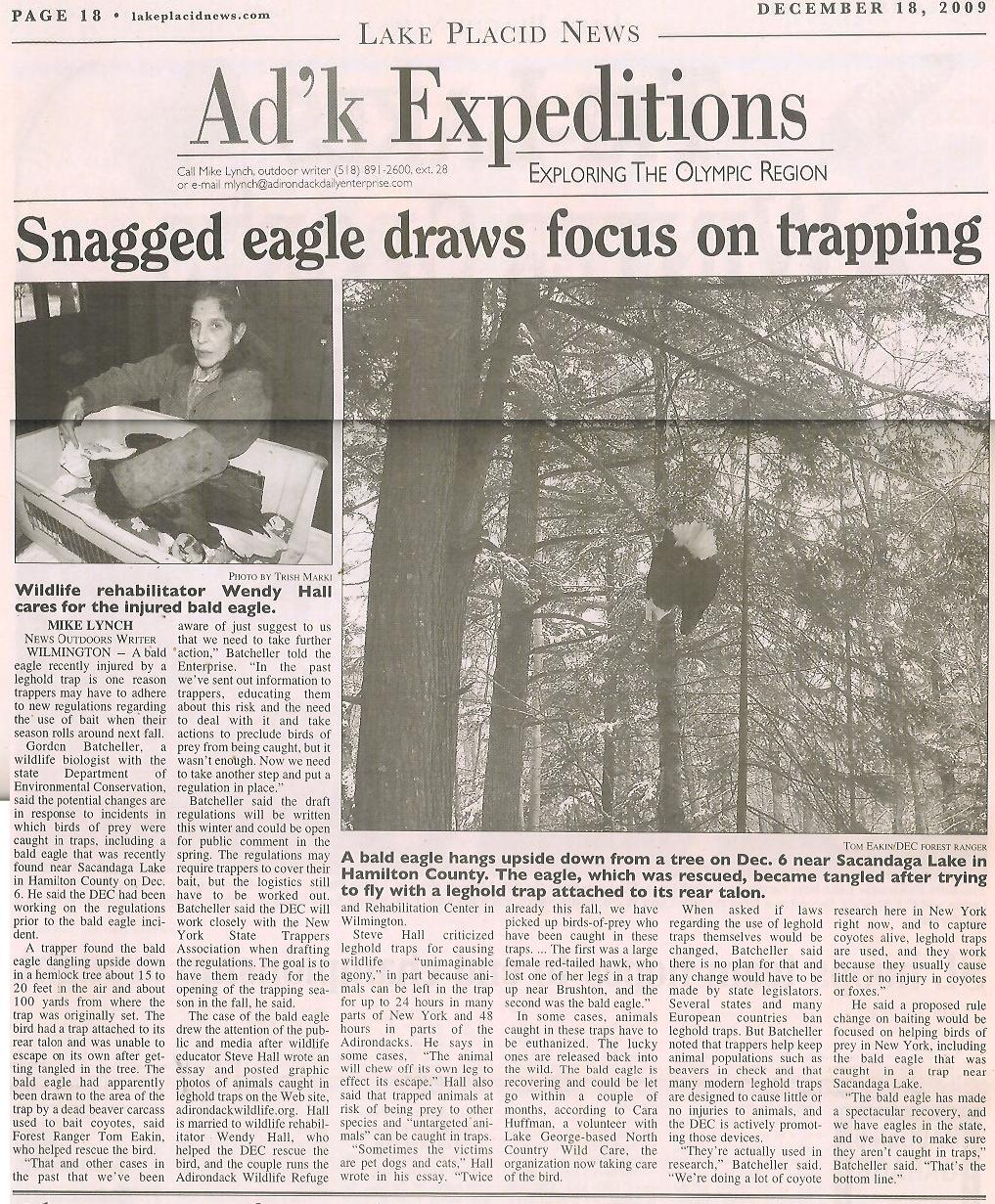





Warning: Graphic photographs below!
This eagle managed to break the trap's chain free, but after flying away with the trap still clamped on his foot,
he became tangled, and dangled himself from this white pine branch.
Photos above by NY State Dept. of Environmental Conservation
|
About 500,000 hunters
spent over $700
million a year in New York State, so hunters are key contributors to
New York's tourist revenue, helping many of us in the North Country. It
is
often hunters and fishermen who alert us and other rehabbers to injured
or disabled wildlife, and when it comes to preserving the wild, whether
in the Adirondacks or elsewhere, conservationists have no closer allies.
While deer killed by cars are the largest contributor in feeding the wolves, foxes, coyotes, bobcats and eagles at the Adirondack Wildlife Refuge, hunters provide the remains of harvested deer, and while some trappers harvest both the meat and pelt, others want only want the pelt, and the animals they bring us are typically animals that are either common in the Adirondacks, or, thanks to the dearth of predators, in need of control, such as beaver and muskrat. Many Americans are unaware of the fact that the pre-Revolutionary War history of the economy of the New World, was largely based on the control of fur trading, in which native Americans swapped furs for everything from useful tools like iron axe heads to culture disrupting influences like alcohol. The shifting allegiances of native Americans, Dutch, French and English trappers, and their middlemen, along with companies such as the Hudsons Bay Company, not only flooded the European fashion market with furs from the new world, , principally beaver and deer, but triggered wars over efforts to control the access to furs. Agrarian and fashion conscious Europe had long since largely eliminated their own beavers, and the value of furs continued to skyrocket until the introduction of Chinese silk. America had eliminated all but isolated fragments of beaver populations by the dawn of the 20th century. With the advent of the conservation movement, however, beaver have seen their numbers increase dramatically, as the number of people involved in trapping has declined, along with the absence of wolves, their number one predator. Beaver are a welcome symbol of wilderness for tourists, hikers and campers, but our tolerance dims when their activities affect the processes of farming, trade and transportation. Beaver create dams in the rivers, streams and wetlands which fill the lowlands in our burgeoning exurban and suburban sprawl, and can have a dramatic impact, flooding private property and pastures, causing septic and even toxic field overflows, and damaging the roads and train tracks which wind through river valleys and lowlands. Such damages have created a new business for trappers, transforming many into pest control businesses, while leading to the invention of "beaver deceivers", and other systems of overflow pipes, protected by fences and mesh. Beaver Deceivers thwart flooding by beavers, by controlling overflow, while eliminating the very sounds of running water which inspire beavers to dam in the first place. While the recovery of beavers means they pretty much have to be controlled in some areas today, flow control devices are more efficient than traps, because they control the potential for flooding damage by beaver families, while trapping temporarily removes one beaver, until other beavers arrive to occupy the freed-up territory. All this aside, we will never understand why New York continues to permit the use of leghold traps for wildlife. They banned the use of snares, toothed leghold traps, and leghold traps broader than 7 and 1/4 inches, but this does not really address the two main problems with the non-toothed clamp traps which are still legal in New York. The first problem is that any wildlife so trapped may suffer greatly, and in many documented cases, the animal will chew off its own leg to effect its escape. (For example, meet "Tripod" the Grizzly bear, below). These traps do not legally need to be checked by the trapper more than once every 24 to 48 hours, depending on which region the trap is set in, which means the captive animal not only may suffer for long periods, but runs the additional risk of drawing in predators attracted by the noise of the creature's struggles, and who will naturally take advantage of the creature's inability to flee. Some folks say that's nature. We call it interference. The second problem is that untargeted animals will be caught in the traps, as the photos on this page attest. Sometimes the victims are pet dogs and cats. Twice already this Fall, we have picked up birds-of-prey who have been caught in these traps. In both cases, the trapper conscientiously reported the accident, which is how the NY DEC (Department of Environmental Conservation) and NCWC (North Country Wildcare), a network of rehabbers we belong to, became involved through the NCWC hot line (518-964-6740). The first was a large female red-tailed hawk, who lost one of her legs in a trap up near Brushton, and the second was the bald eagle, both of which are pictured here. The third is a barred owl, who apparently flew around with the trap on its leg, before expiring. The eagle was strong enough to loosen the trap's chain, and flew away with the trap still fastened to its talon, before getting the chain entangled with the branch of a white pine in Moffitt Beach Campground on Lake Sacandaga, which left the eagle dangling from the branch. This is where the trapper located the eagle, before calling the ranger. Our squeamishness about trapping distracts from the real cruelty, both in terms of practice and the number of animals affected, and that cruelty is fur farms. The best way to reduce fur usage, is to refuse to buy coats and garments which use real fur. Many folks have this romantic notion that fur garments come from trappers, while others believe that the existence of fur farms, essentially concentration camps, where fox, mink and other fur bearers are raised for the purpose of supplying raw material for fur garments, relieves them of the inconvenience of worrying about the suffering of other creatures. Imagine an entire industry whose modus operandi is based on cruelty. Trappers argue that the creatures they trap, in contrast to farm raised animals, get to live in the wild, before they are harvested, which is true, but the fact of their suffering and the suffering of non-target animals remains, and the comparison offered represents a choice between two terrible fates. And they are correct that the animals raised on fur farms spend their lives in tightly confined quarters, until they are finally "harvested" by electrocution or lethal injection. 20% of the animals utilized in the fur trade come from animals trapped in the wild, and ironically, the untargeted species, or so-called "trash species", often end up being used in the manufactured furs anyway. So your "mink" coat may include some coon and possum. In addition, all this happens in a market where synthetic furs look more attractive, last longer, keep you warmer, and are less expensive. What does it say about our character, if the key to our preference for real fur, is simply that its raw material was once living? More importantly, synthetic furs allow you to celebrate and display wildlife, without actually harming any creatures, just as hunting with your camera spares the "trophy" for others to enjoy. Like many issues, the question of trapping becomes much more complicated when you get beyond the gut emotional reaction, to the practical aspects of public safety, control and the lack of natural controls like predators. The ideal method of control tends to be to preserve the animal's territory, while minimizing the damage to private property and public safety, as in the case of flow control devices to minimize beaver damage. At the same time, we should have much more sympathy for the hunter and trapper, who make their living off the land, literally feeding and clothing themselves, than we have for the hypocrites who often decry the suffering of animals, but still buy meat from the factory farm and furs from the fur farm. If you must trap animals, or if you use the resulting pelts to make outer garments for yourself or your family, please consider the use of padded leghold traps, which have rubber pads on their jaws, and generally hold the animal without seriously injuring it. Such traps are often used by wolf researchers in the wild. Conibear or body gripping traps, are out of public favor, because they're designed to kill beaver and muskrat quickly, but, except when they are used on land, have the advantage of missing most non-target animals, because they are usually submerged in water. The public generally ignores the issue of displacement, meaning that trapped animals are often killed anyway, as relocating animals is often impractical or self-defeating in the long run. Another alternative are HavaHart traps, which trap the animal inside a cage, without harming it. The obvious advantage is that any unwanted species are more likely to be deterred from approaching the trap, and if captured, can quickly be sprung. In addition, the terrified creature is safe from attack by predators, and its suffering is minimized. The disadvantage to the trapper is the increased cost of the traps, and the fact that the HavaHarts are not quite as reliable in capturing the animal as the legholds are. But, if you agree to let your heart, rather than just your wallet, determine the most humane means of capturing these creatures, we hope you'll go with the HavaHart. Steve Hall
|
Cat caught in leghold trap, below right

Left & Center Photos by NY State Dept. of Environmental Conservation, right photo by Defenders of Wildlife
Wendy brought the eagle down to Trish & Kara of NCWC, who have experience with eagles.
Photos above and below by Trish Marki
eagle talons
this gorgeous female red-tailed hawk had its leg severed in a leghold trap
Red-tailed photos by Sasha Ivanov.
Barred Owl, killed by a leghold trap, photos by Trish Marki.
"Tripod", a young grizzly who became caught in a leg-hold trap when he wandered out of Denali National Park
in the Fall of 2011. Tripod chewed his paw off to secure his release. Photo by Steve Hall.
Click article below for web version

| Home |
Release of
Rehabbed Animals |
Learn
About Adirondack & Ambassador Wildlife |
Critter
Cams & Favorite Videos |
History
of Cree & the Adirondack Wildlife Refuge |